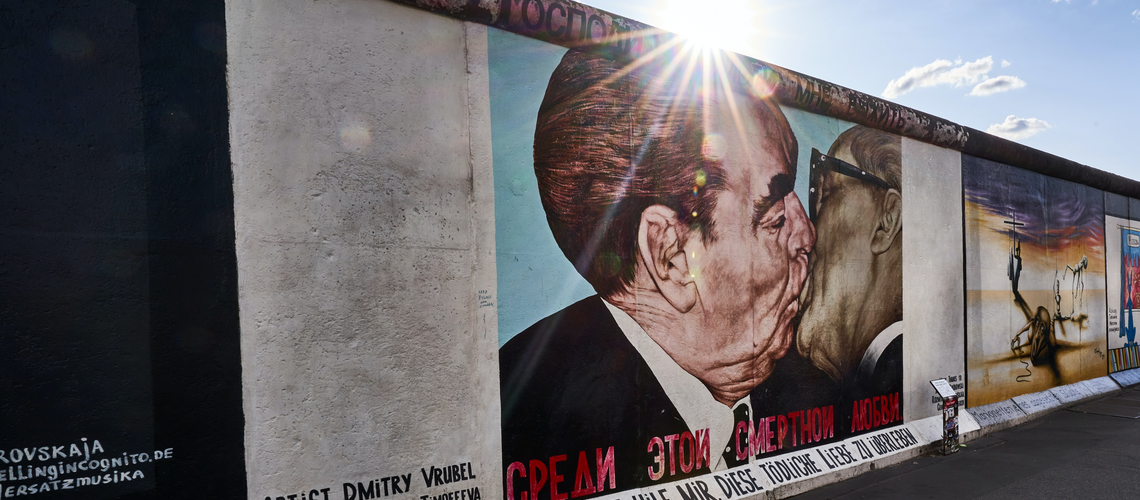
The Day of German Unity
October 3 is a national holiday in the Federal Republic of Germany. But why? In this article, we will give you a brief insight into German history and explain what is celebrated on the Day of German Unity.
An excursion into German history
The DDR and the construction of the Berlin Wall
Let's go back to 1945: After the Second World War, the victorious powers divided Germany into four occupation zones. The largest of these is the Soviet zone. While the other three occupation zones try to integrate the country into the Western economic markets, the Soviets plan to turn the country into a communist workers' state. In 1949, the “Deutsche Demokratische Republik” (“German Democratic Republic”) is founded, the “DDR”.
There is only one party in the DDR – the “Sozialistische Einheitspartei Deutschlands”, “SED” (“Socialist Unity Party of Germany”) – and it lets the “Ministerium für Staatssicherheit” (“Ministry of State Security”), or in German short “Stasi”, monitor the population. Anyone who disagreed with the policy was automatically an enemy of the state.
The DDR seals itself off from the West. The border is strictly monitored and in 1961 the city of Berlin is divided into two halves by a wall: The Berlin Wall separates East from West Berlin. The DDR government wanted to prevent the inhabitants from leaving the country.
“Die Wende”
Almost exactly 40 years after its founding, the political leadership of the DDR weakened. The economy is in crisis and numerous citizens manage to flee abroad and escape the DDR's grasp. Political resistance also arose within the DDR, and the DDR's protecting power, the Soviet Union, had to contend with crumbling power structures.
Finally, the opening of the border was announced at a press conference on November 9, 1989. Immediately, DDR citizens streamed across the border into the West. Ironically, it later turned out that the opening of the border had not even been planned at that time. Günter Schabowski, who had only been in the post of press spokesman for a few days, had missed much of the previous briefing.
The press conference and its aftermath are also known as the “Mauerfall” (“fall of the Wall”). This term is easily misunderstood, because the Berlin Wall still stood for some time – but it had lost its significance as a symbol of the division of the city. This event, the reunification of Germany, and the subsequent changes in the country are also summarized under the German term “die Wende” (“The turning point”).
Today's holiday
Less than a year after the opening of the border, Germany was reunited on October 3, 1990. Since then, the “Day of German Unity” (German: “Tag der Deutschen Einheit”) has been celebrated on this day. The German national holiday is also colloquially referred to as “Unity Day” (”Tag der Einheit”) or “Reunification Day” (“Tag der Wiedervereinigung”).
Even before reunification, there was already a “Day of German Unity” on June 17, which, however, had a different background: On this day, a popular uprising in the DDR, which was put down with Soviet tanks, was commemorated, demanding free elections. With reunification, this holiday became obsolete and was replaced by today's holiday.
Commemoration of reunification
October 3 is a public holiday: Schools, stores and offices remain closed and most people do not go to work. In Berlin, a large civic festival is organized to mark the occasion. There are show stages and entertainment programs around the “Straße des 17. Juni” (“Street of June 17”), the Brandenburg Gate and in front of the “Reichstag” building.
On the Day of German Unity, the media will show reports about the life of that time and the events that led to reunification. The Federal Chancellor and the Federal President also give speeches that are shown by many television stations.
In the meantime, the Berlin Wall has been almost completely removed, only individual pieces are still standing as monuments in the city. The largest remaining section of the wall stretches over 1.3 kilometers and is open for viewing as part of the "East Side Gallery" in Berlin Friedrichshain. Numerous artists have placed their artwork on the remains of the wall there.
Even if younger Germans did not experience the time before reunification, it is still an incisive event in German history.
Would you like to learn more about German history and learn German at the same time? We offer German courses at six different locations in Germany, including Carl Duisberg Training Center Berlin.
